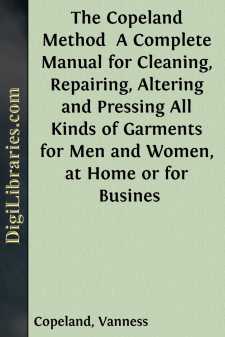Categories
- Antiques & Collectibles 13
- Architecture 36
- Art 48
- Bibles 22
- Biography & Autobiography 813
- Body, Mind & Spirit 142
- Business & Economics 28
- Children's Books 17
- Children's Fiction 14
- Computers 4
- Cooking 94
- Crafts & Hobbies 4
- Drama 346
- Education 46
- Family & Relationships 57
- Fiction 11829
- Games 19
- Gardening 17
- Health & Fitness 34
- History 1377
- House & Home 1
- Humor 147
- Juvenile Fiction 1873
- Juvenile Nonfiction 202
- Language Arts & Disciplines 88
- Law 16
- Literary Collections 686
- Literary Criticism 179
- Mathematics 13
- Medical 41
- Music 40
- Nature 179
- Non-Classifiable 1768
- Performing Arts 7
- Periodicals 1453
- Philosophy 64
- Photography 2
- Poetry 896
- Political Science 203
- Psychology 42
- Reference 154
- Religion 513
- Science 126
- Self-Help 84
- Social Science 81
- Sports & Recreation 34
- Study Aids 3
- Technology & Engineering 59
- Transportation 23
- Travel 463
- True Crime 29
The Copeland Method A Complete Manual for Cleaning, Repairing, Altering and Pressing All Kinds of Garments for Men and Women, at Home or for Busines
by: Vanness Copeland
Description:
Excerpt
LESSON I.
EQUIPMENT.
Introduction: A few hints to the beginner as well as to those now in the business. The tools required and the best method of using same, for work at home or for business.
The tools required for cleaning, repairing and pressing at home, or for business are as follows:
For work at home, use an ordinary kitchen table with smooth top. For use in business, a table eight feet long, three feet wide and thirty inches high (or as high as is convenient for the presser, this may be easily determined by using). This is called a tailor's bench. The balance of the tools are the same for work at home or for business.
The kitchen table or tailor's bench may be used for several purposes; the first of which is to place the iron, press-jack, sponge cloth, and garment while cleaning and pressing. Also for men to sit on while sewing.
THE IRON.
One may use an ordinary laundry iron (but would advise the purchase of a solid iron or tailor's goose, weighing from fourteen to twenty-two pounds, or according to one's strength), one may heat the iron on a coal range, gas or oil stove; or one may use a gas or electric iron, which are being used with great satisfaction, and are easily handled, being of little trouble to operate, also doing the work well. However, it is best to use whatever one considers most convenient, cheapest and best for the locality in which one resides.
The iron is heated and placed on the iron rest, which has been placed on the table for that purpose, to the right of the presser, and is applied to the sponge cloth (that has been wrung out almost dry), causing steam to penetrate that part of the garment being pressed, thereby refreshing the cloth.
The presser should have control of the iron at all times, also see that the iron is not too hot before using by testing it on a piece of light colored woolen material. If it scorches it is too hot for use, wait for a few minutes to cool.
When pressing move the iron from place to place, on the part to be pressed, by lifting it clear each time, instead of shoving it along as some do. (To shove the iron along on the work is apt to stretch garments where not required, and also cause wrinkles). Keep the face of iron smooth by rubbing wax over the surface frequently, thereby removing any lint or dirt that may accumulate from time to time.
A press-jack such as the tailors use, is made of two hardwood boards, thirty-five inches long, one inch thick, planed both sides and edges and cut egg-shape; the wide end being eight inches in width, and the narrow or small end, four inches wide, one forming the top and the other the bottom.
Between the top and bottom are screwed two blocks of solid wood, four by four inches, and six inches high. The first one is screwed to the top and bottom, three inches from the large end, and the second block is screwed to the top and bottom, seven inches from the large end, thereby leaving a space to the small end, of twenty-eight inches, for convenience in handling the garments while pressing....


